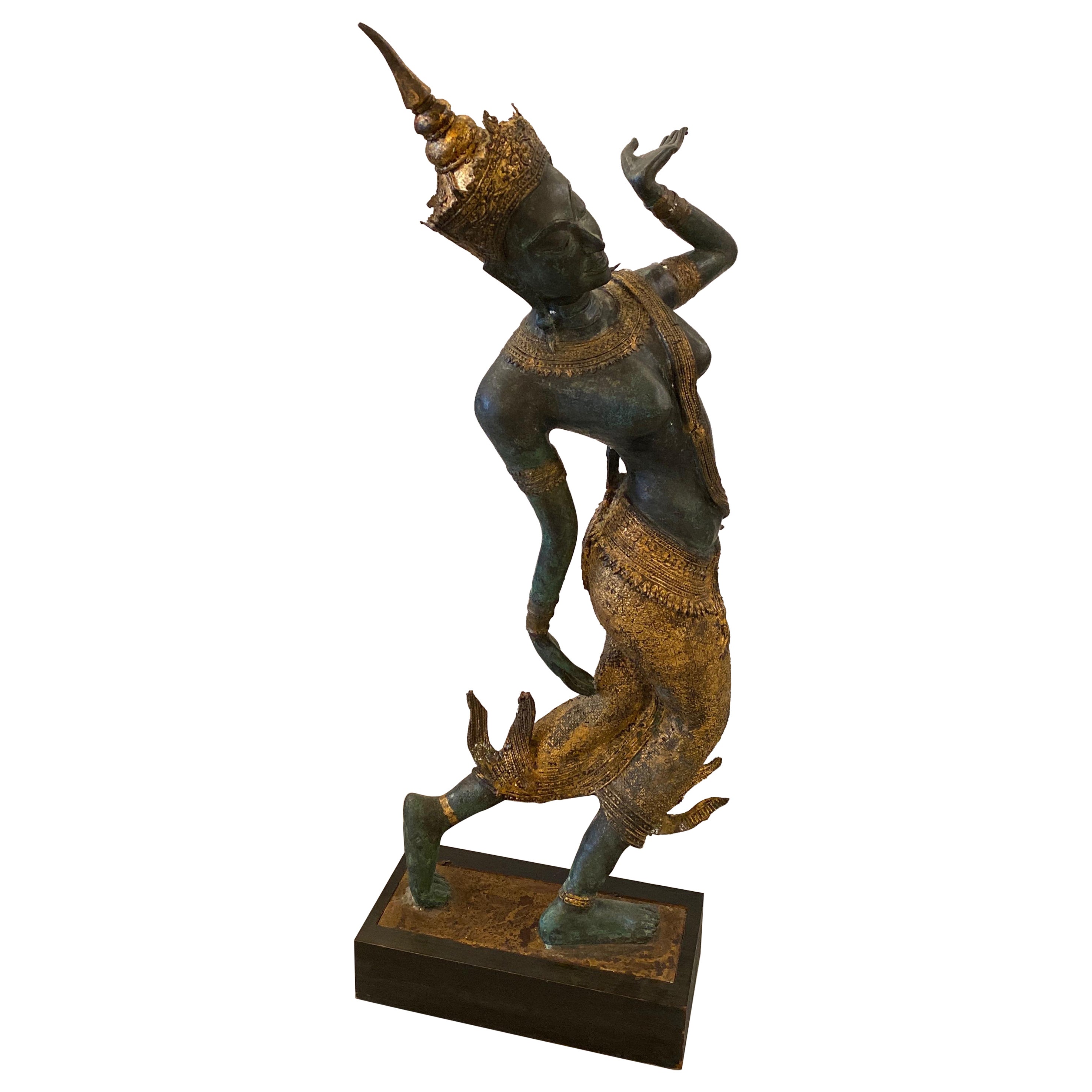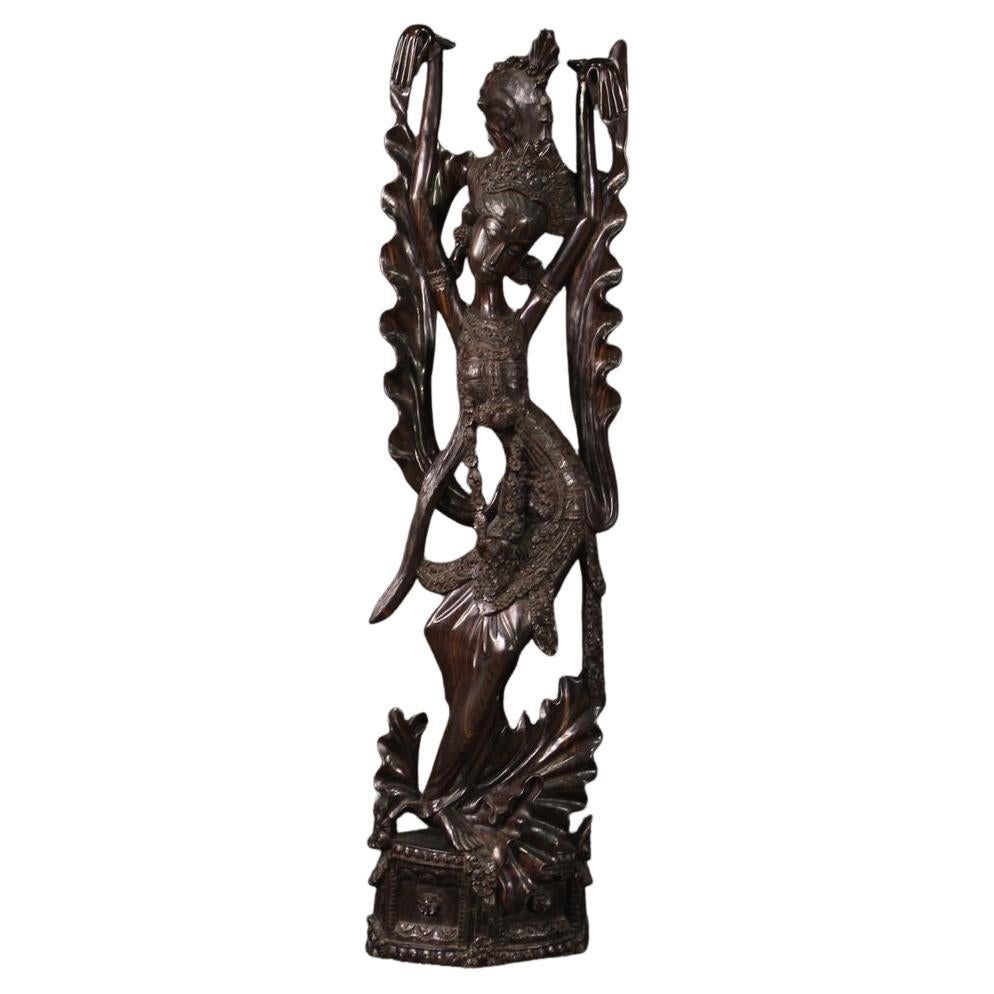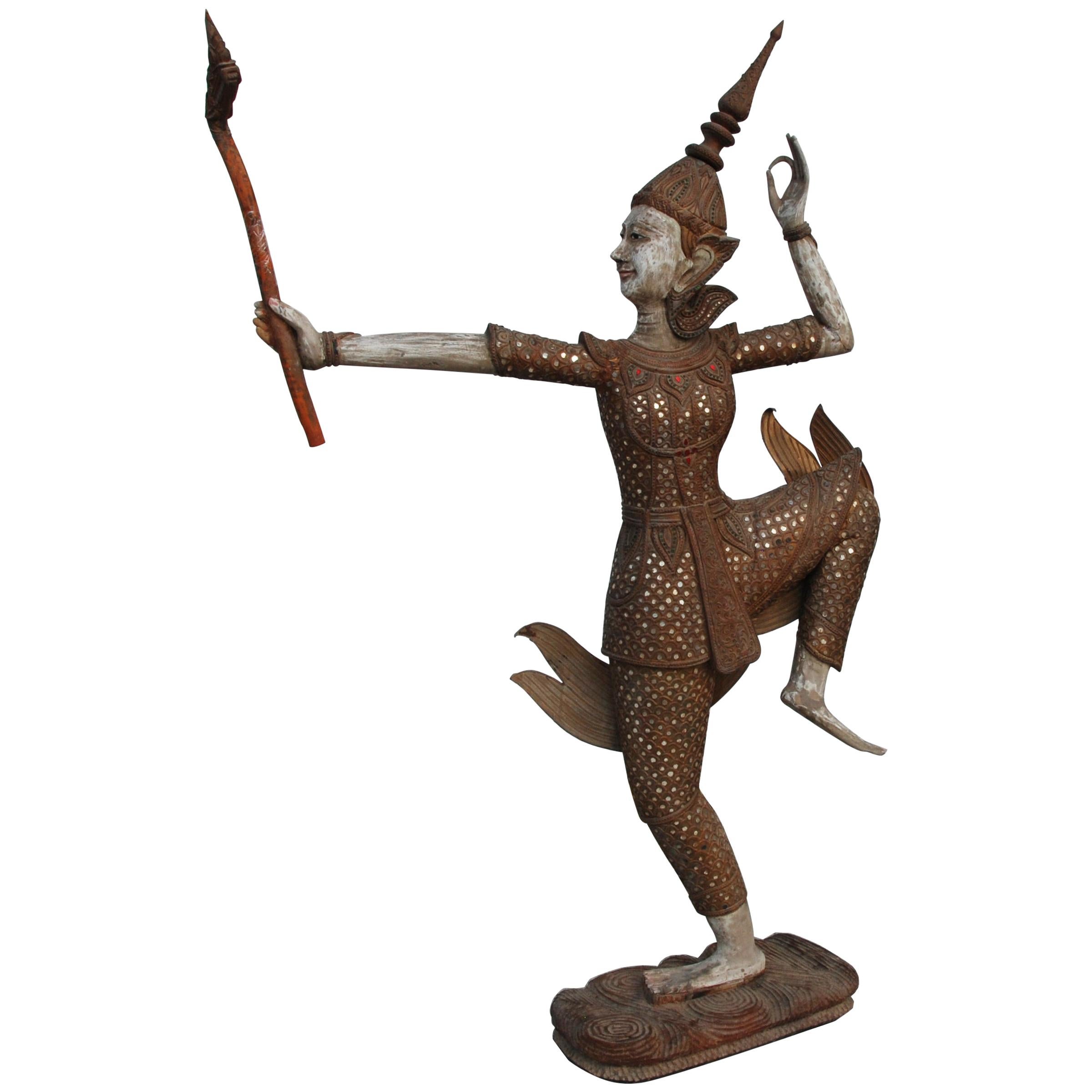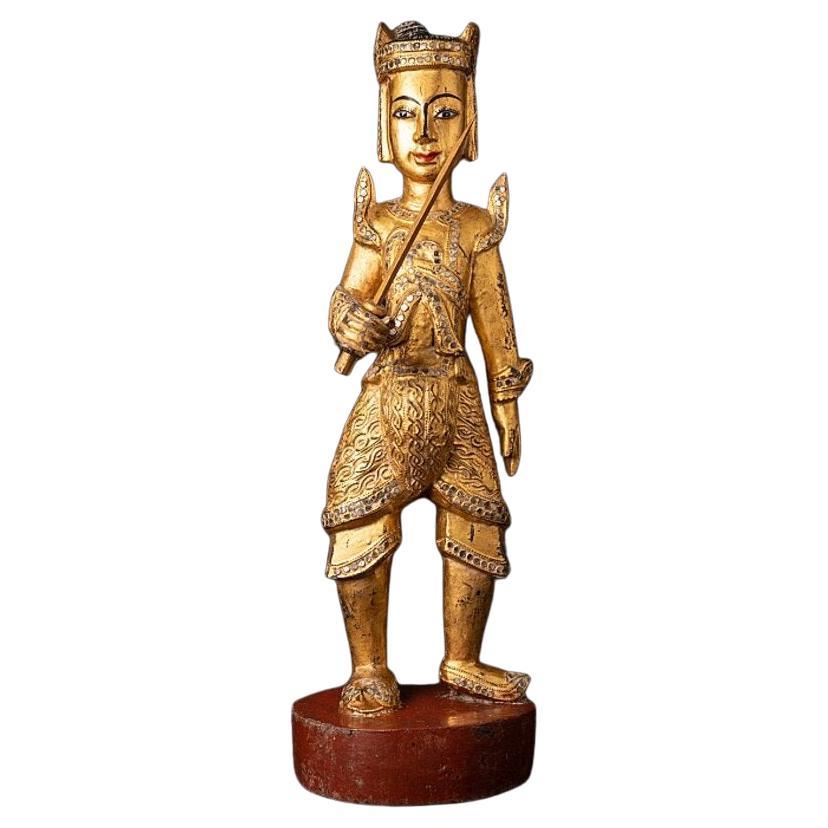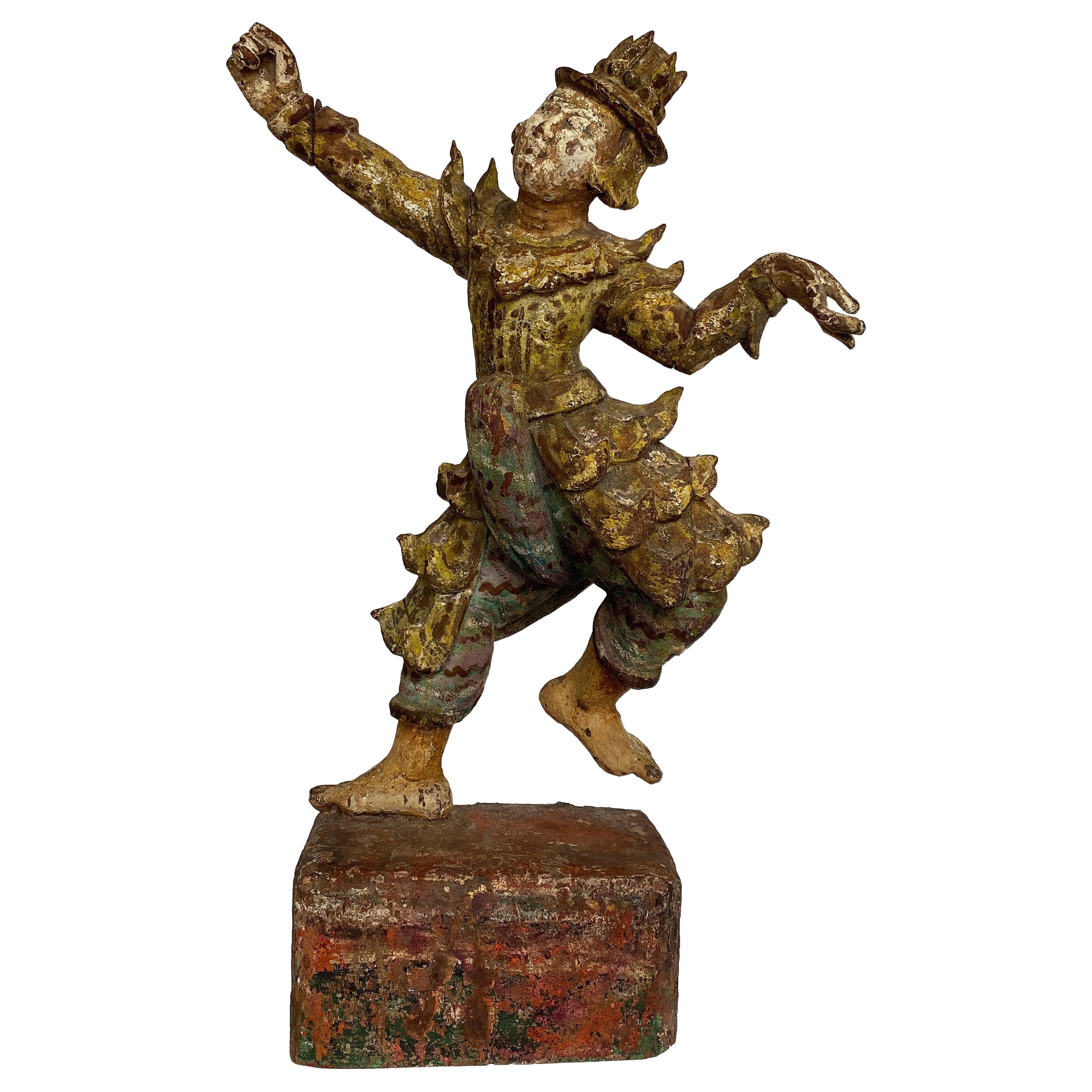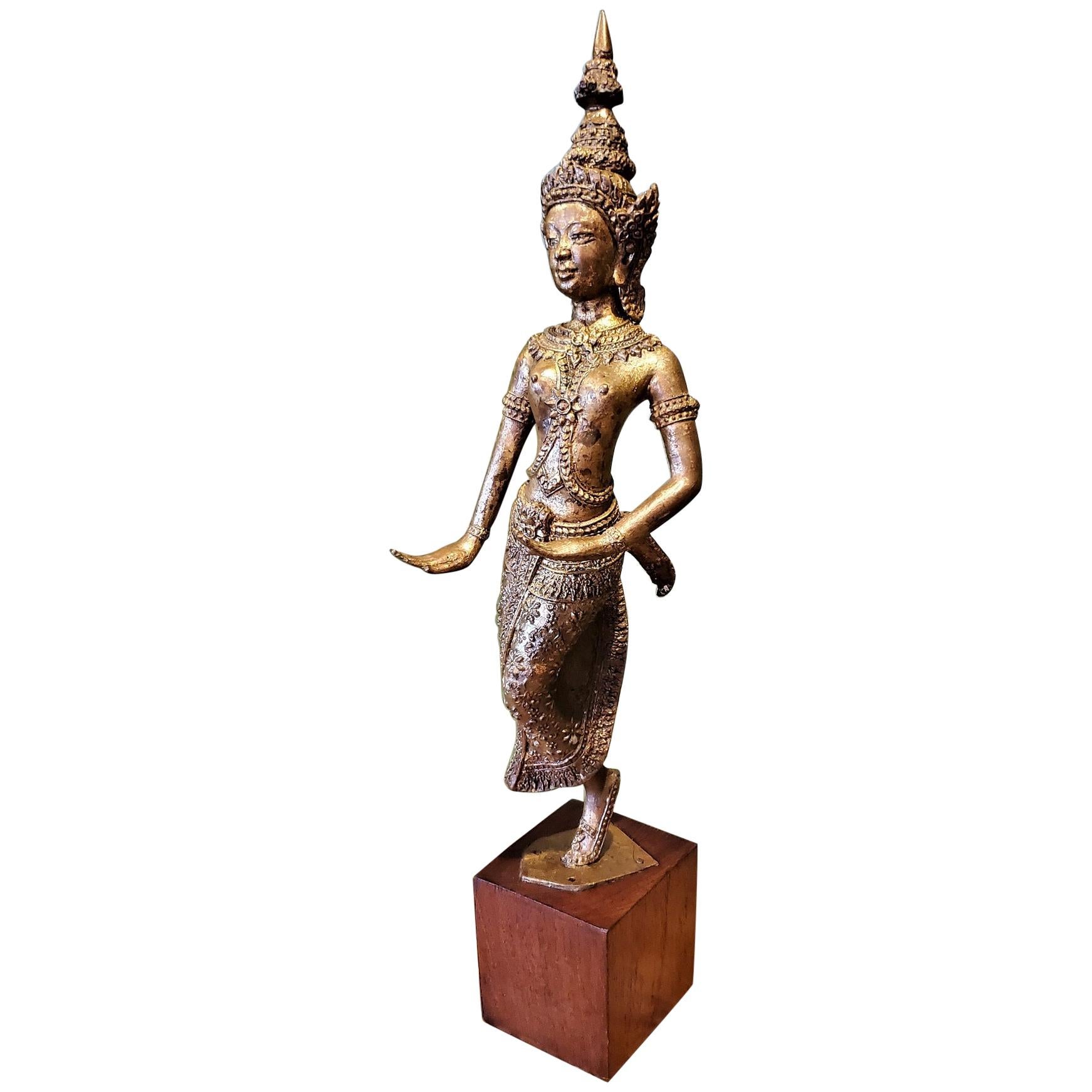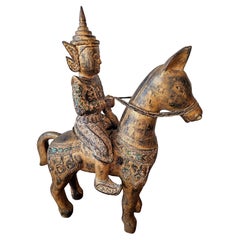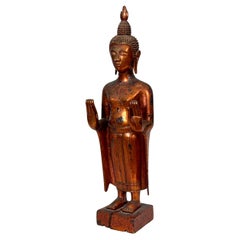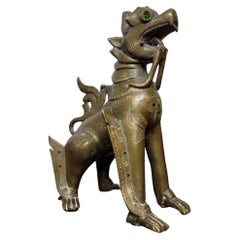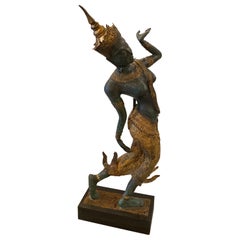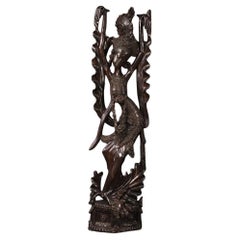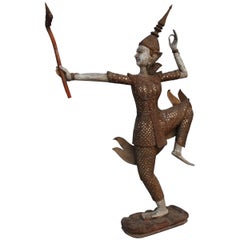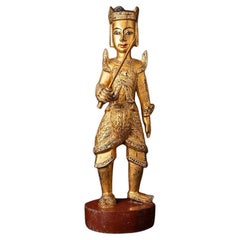Items Similar to Antique Burmese Mandalay Period Buddhist Dancer Nat Spirit Deer Figure Sculpture
Want more images or videos?
Request additional images or videos from the seller
1 of 21
Antique Burmese Mandalay Period Buddhist Dancer Nat Spirit Deer Figure Sculpture
$11,000
£8,346.55
€9,543.53
CA$15,364.02
A$17,082.70
CHF 8,919.64
MX$207,938.02
NOK 113,810.74
SEK 106,635.23
DKK 71,225.12
Shipping
Retrieving quote...The 1stDibs Promise:
Authenticity Guarantee,
Money-Back Guarantee,
24-Hour Cancellation
About the Item
A rare and exceptional antique Southeast Asian Burmese hand carved and gilded teak wood religious figure Buddhist temple -monastery sculpture.
Exquisitely hand-crafted in Burma (present day Myanmar) in the late 19th century, finely sculpted from a single piece of teakwood, exceptionally executed in period Mandalay taste, highly detailed and decorated, showcasing the most exquisite craftsmanship throughout.
Modeled in an exceedingly rare and unusual form, depicting a tall standing Na spirit figure, adorned in fanciful Royal dancer garment, elaborately decorated and embellished with brilliant polychrome colored mirrored glass jewel inlays, red lacquered dress tail, he stands carrying a golden stag deer around shoulders and neck, the naturalistic deer having delicate four point antlers, all over an ebonized base, resting on a custom later Thai wooden pedestal stand.
Dimensions: (approx)
Overall: 27"h, 9"w, 7.75"d
Figure: 19.25"h, 9"w, 7.5"d
Base 7.75"h, 8"w, 7.75"d; 10.5"h with post
Condition:
A superb museum quality example, wonderfully preserved original antique condition with nicely aged warm rich dark patina and minimal losses.
*Additional photos available upon request
We immediately gravitated towards it upon first sight, and have not seen another piece quite like it form, quality, or scope. It would look amazing in just about any setting, with its remarkable design and visually striking eye-catching light reflection, it's sure to become a focal point of any space, while adding a thoughtful touch of rich cultural history, sophistication, elegant warmth, tranquility and serenity to any home!
Provenance / Acquisition:
Personal property of Genshiro Kawamoto (b.1932), a Japanese real estate tycoon and avid decorative arts collector.
To give an idea of both the size of the collection and the wealth Mr. Kawamoto had amassed, he purchased numerous (many 100s) of multi-million dollar homes in Hawaii, always paying cash. A string of homes he purchased for $2M-$20M each with the intent of using them as museums, (most people use storage units) just to house and display items from his extensive collection of antiques and artifacts. About 30 properties with a collective value of $200M in the Kāhala area of Honolulu he left vacant for decades, allowing them to fall into disrepair and get boarded up, attracting many complaints and media attention.
Mr. Kawamoto was in the procession of building one of the most expensive homes ever built in Hawaii at the time of his arrest and subsequent deportation to his native country, Japan, where he was found guilty of tax evasion, sentenced to four years in prison and had his assets seized and auctioned off.
We acquired this wonderful example from a prominent antiques dealer in Maui, Hawaii, who personally knew Mr. Kawamoto and procured this sculpture from the estate.
Mythological History:
The golden deer is relevant in Buddhism and Hinduism traditions, both adopting the use of the golden deer to teach moral lessons, in the form of animal fables.
In Buddhism, the story of the golden deer is part of a collection of tales, named, the ‘Jataka Tales’. The tales centre on the previous lives of the Buddha (O’Brien, no date a). Whereas in Hindu mythology, the golden deer features in the Ramayana epic.
The story of the golden deer in Buddhism, goes back to a previous life of the Buddha. In this life he is named Bodhisattva and has been born as a beautiful golden deer. He knows that the hunters would love to hang his hide on their wall so he is reluctant for his identity to be known. Risking everything, he rescues a man who is stuck in a treacherous current, who in due course promises to never reveal the Bodhisattva’s existence. The rescued man breaks this promise and shows the King where the golden deer is. This was because he was tempted by the Queens offer to make him live a rich and wealthy life. Ultimately, the King finds out about the rescued man’s betrayal and prepares to kill him, however, the Bodhisattva preaches that you should ‘not strike one who is already stricken’. The story concludes with the golden deer stood on a throne speaking the word of the Dharma.
The story teaches that (unlike the rescued man) you should never go against your word, or break promises. Furthermore, it teaches two wrongs don’t make a right, for example the King wanting to kill the rescued man for breaking a promise, and the rescued man thinking he can betray the golden deer if he does good acts in later life. However, the overriding moral of the story is to show compassion to all creatures and treat them all as family.
The golden deer in Hinduism, features in the Ramayana (‘’Romance of Rama’’) epic (Narayan, 1972). The Ramayana is an ancient Sanskrit epic, following Prince Rama’s mission to rescue Princess Sita from Ravana. It is traditionally attributed to the authorship of Valmiki and dated to be around 500 BCE to 100 BCE (Quick guide to the Ramayana, no date). Ravana, the evil antagonist, plans to capture Prince Rama’s wife Princess Sita by luring Prince Rama into the forest, meaning Sita will be alone with no protection (Ravana Plans Abduction of Sita The Story of Golden Deer Spiritual Bangalore, 2009). Ravana orders his accomplice Marich to transform into a beautiful golden deer. Princess Sita desires the skin of the golden deer so Prince Rama chases after it, intent on capturing the golden deer to please his wife. Eventually he catches up with the deer and manages to shoot the deer with his bow and arrow. However, Marich screams out in pain, mimicking Prince Rama’s voice. Princess Sita heard the screams, and begs Rama’s brother Laxmana to go save Rama. As soon as Laxmana travels into the forest and Princess Sita is left unattended, Ravana goes forward with his plans. Using his power he changes himself into a monk, and begs Sita to give him some food. Laxmana had previously drawn a line for Sita, which if she went past she would burn. Despite this, Sita takes her chances and steps out to feed the innocent looking Monk. As soon as she does this, Ravana lifts Sita onto his shoulders and flies far, far away.
Ultimately I believe the moral of the story is to stray away from temptation (the prospect of having the golden deer’s skin), and also, like the Buddhism fable, to show compassion to all creatures and treat them as family.
To conclude, a golden deer features in tales in Buddhism and also Hinduism. The golden deer is used in both as a desirable animal; Princess Sita wanted the deer in the Hindu tale, and in the Buddhist tale, the Queen wanted the deer. Furthermore, the desirable animal cause’s temptation in both cases, and giving into that temptation is what proves the downfall for the rescued man and Princess Sita. Therefore, both stories display how you should not give in to temptation and arguably more importantly, show that you should have compassion to all creatures and treat them all as family.
Mandalay period:
1853 – 1948 Mandalay was considered the center of the Buddhist universe in Myanmar. King Mindon moved the capital from Amarapura to this new site and called it the city of Mandalay. Tradition maintains that Guatama Buddha visited the sacred peak of Mandalay Hill with his disciple Ananda and proclaimed that on the 2400th anniversary of his death, a metropolis of Buddhist leaning would be founded on the plain below the hill. The political center of this new city had the perfect geometrical form of a Buddhist Mandala, for which the city was named, Mandalay. The Mandalay period ends at the time when the Burmese gained its independence from the British Colonial rule.
- Dimensions:Height: 27 in (68.58 cm)Width: 9 in (22.86 cm)Depth: 7.75 in (19.69 cm)
- Materials and Techniques:
- Place of Origin:
- Period:
- Date of Manufacture:circa 1890
- Condition:Wear consistent with age and use. Minor losses. A superb museum quality example, wonderfully preserved original antique condition with nicely aged warm rich dark patina, wear, minimal losses consistent with age, handling and display. Later stand.
- Seller Location:Forney, TX
- Reference Number:1stDibs: LU5977228400592
About the Seller
4.8
Platinum Seller
Premium sellers with a 4.7+ rating and 24-hour response times
Established in 2013
1stDibs seller since 2021
294 sales on 1stDibs
Typical response time: <1 hour
- ShippingRetrieving quote...Shipping from: Forney, TX
- Return Policy
Authenticity Guarantee
In the unlikely event there’s an issue with an item’s authenticity, contact us within 1 year for a full refund. DetailsMoney-Back Guarantee
If your item is not as described, is damaged in transit, or does not arrive, contact us within 7 days for a full refund. Details24-Hour Cancellation
You have a 24-hour grace period in which to reconsider your purchase, with no questions asked.Vetted Professional Sellers
Our world-class sellers must adhere to strict standards for service and quality, maintaining the integrity of our listings.Price-Match Guarantee
If you find that a seller listed the same item for a lower price elsewhere, we’ll match it.Trusted Global Delivery
Our best-in-class carrier network provides specialized shipping options worldwide, including custom delivery.More From This Seller
View AllAntique Indonesian Carved Deer Architectural Temple Sculpture
Located in Forney, TX
A rare and incredible Indonesian hand carved and painted red deer architectural salvaged temple ornament.
Dating to the 19th century or earlier, hand-...
Category
Antique 19th Century Southeast Asian Folk Art Sculptures and Carvings
Materials
Wood, Paint
Large Southeast Asian Burmese Thai Jeweled Giltwood Figure On Horse Sculpture
Located in Forney, TX
A large and most impressive Southeast Asian carved giltwood figure of a horse and mounted rider.
Early 20th Century, likely from Burma (present day Myanmar) or Thailand, possibly Hi...
Category
Early 20th Century Southeast Asian Folk Art Sculptures and Carvings
Materials
Metal
Large Antique Khmer Carved Gilt Lacquered Standing Buddha Figure Statue
Located in Forney, TX
A beautiful antique Khmer hand carved wooden Buddhist figure.
Originating in Cambodia, Laos, Vietnam or Thailand, 19th century or earlier, the exceptional Southeast Asian antique...
Category
Antique 19th Century Southeast Asian Sculptures and Carvings
Materials
Wood, Lacquer
19th Century Burmese Jewel Inlaid Bronze Temple Guardian
Located in Forney, TX
A scarce, high-quality antique Burmese jewel inlaid solid bronze chinthe sculpture.
Dating to the late 19th century, likely originating in the Mandalay region of central Burma, the fearsome looking beast depicted in traditional Burmese iconography and important architecture, especially as a pair, the protective temple guardians placed flanking the entrances of Buddhist religious pagodas and monasteries.
Burma; circa 1880
PROVENANCE:
The estate of Mr. Wesley and Mrs. Suzanne LaFever, Beverly Hills, California.
ACQUISITION:
We acquired this outstanding example from the reputable auction house, Austin Auction Gallery, Austin, Texas. Fine Estates and Antiques catalog, December 2021
DESCRIPTION:
Exquisitely sculpted and cast of heavy, patinated solid bronze, finely detailed and decorated throughout, intricately engraved with scrolling ornamentation and fine detailing work, old nicely aged polished finish developing a warm, mellow patina with highly desirable scattered verdigris, minor inlay losses add to the charming antique character.
Stoic in stance, posed at attention proudly squatting back on its haunches, front legs straight, possibly roaring with head up and straight ahead, mouth ajar with teeth and long tongue exposed, ornate armor plating and horned mane, fanciful stylized tail, inset with Myanmar style brilliant colored mirrored glass jewels.
BRIEF HISTORY / BACKGROUND:
Predating the use of coins for money, brass weights cast in the shape of iconic animals like the Chinthe were commonly used to measure standard quantities of staple items.
Chinthe, the Burmese word for lion, while leograph of Chinthe is an artistic highly stylized lion; the rare Southeast Asian Burmese equivalent to Foo Dogs, Japanese Komainu, Tibetan Snow Lion...
Category
Antique Late 19th Century Asian Sculptures and Carvings
Materials
Bronze
Antique Korean Carved Polychrome Wooden Buddhist Figure Sculpture
Located in Forney, TX
Bring a touch of peaceful tranquil serenity and help ward off sickness and negative energy with this large Joseon dynasty (1392–1910) antique Asian hand carved and painted wood Buddh...
Category
Antique 19th Century Korean Folk Art Sculptures and Carvings
Materials
Wood
19th Century Hindu Nandi Temple Guardian, Architectural Ornament
Located in Forney, TX
A monumental Hindu Nandi temple gate-guardian architectural ornament, born in India, dating to the 19th century, hand carved and painted, richly detailed, polychrome decorated, the wooden sculpture depicting Nandi, a sacred bull, gatekeeper, and vahana religious deity figure.
Provenance:
Acquired from The Neiman Marcus Corporate Art Collection. Details below.
Dimensions: (approx)
49.5" x 43" x 12"
An important religious folk art work, the Nandi is of carved wood and gessoed cloth, then hand-painted. In Hindu religion, Nandi is the mythical mount of Shiva. The four legs represent truth, righteousness, peace and love.
More than a means of conveyance, Nandi is considered Shiva's constant companion on all his travels, so much so that in any temple dedicated to Shiva, there is a sculpture of Nandi. This symbol is a deity in its own right, and in India there are temples dedicated exclusively to Nandi.
In Hindu symbolism, the bull represents both strength and ignorance. The white or light color of the bull symbolizes purity and justice. Symbolically, the seated Nandi towards sanctum in Shiva temples, represents an individual jiva (soul) and the message that the jiva should always be focused on the Parameshwara. From the yogic perspective, Nandi is the mind dedicated to Shiva, the absolute. In other words, to understand and absorb light, the experience, and the wisdom is Nandi, which is the guru within. The fact that Shiva uses it as a mount symbolizes how this divine figure removes ignorance while instilling strength and wisdom.
A superb example, the life size work is in great overall shape, and presents wonderfully, having beautifully aged patina over the whole, highly desirable original, worn, rustic, naturally distressed, chippy paint, craquelure finish, that's delicate, and enhances the artistic antique character and rich historic depth.
Detailed Condition Report:
Fragile / delicate by design. Loss to one ear, age related checking and separation to carvings, fabric to hind quarters is released and tattered with minor loss, rubbing to paint throughout with wear indicative of age and use; later grey painted mounting blocks are attached to back and hooves.
White glove in-home shipping/delivery available.
Pickup available near Dallas, Texas
Additional Provenance:
Property from the Neiman Marcus Collection. Acquired from Heritage Auction, Design District Gallery, Dallas, Texas.
From The Dallas Morning Newspaper; April 12th, 2021
Neiman Marcus is selling some of its history and valuables that have been displayed and stored for decades as part of the luxury retailer’s corporate art collection.
The Neiman Marcus corporate art collection dates back to 1951, when Stanley Marcus (1905-2002), a life long avid art collector, purchased Mariposa, a large mobile by Alexander Calder and started a long tradition of buying original artwork for new stores as they opened. The Mariposa sold at a Sotheby’s auction last month fetching $18.2 million. The items are being offered through Sotheby's auction house, NYC, New York and Heritage Auction, Dallas, Texas.
Many of the pieces were personally collected by Stanley Marcus from the 1960s through the 1980s.
Some of the pieces are from corporate spaces, stores and the company’s archives, among the items are important antique textiles, tribal robes...
Category
Antique 19th Century Indian Folk Art Sculptures and Carvings
Materials
Gesso, Wood, Paint
You May Also Like
Antique Thai Bronze Sculpture of a Dancer
Located in Lambertville, NJ
An antique bronze figure of a Thai dancer. The patinated and gilt bronze surface, all original. In very good condition with original aged finish. The female dancer with traditional c...
Category
Early 20th Century Thai Sculptures and Carvings
Materials
Bronze
20th Century Carved and Crafted Wood Oriental Dancer Indonesian Sculpture, 1960s
Located in Vicoforte, Piedmont
Indonesian sculpture from the second half of the 20th century. Finely carved and crafted exotic wooden object depicting an oriental dancer of excellent quality. Sculpture made from a...
Category
Vintage 1960s Indonesian Sculptures and Carvings
Materials
Wood
Wood Thai Dancer Statue
Located in Pasadena, TX
6ft wood Thai dancer statue
Thai deity with mirrored accents throughout. Deity is holding a staff, with arm outstretched. Statue is hand carved.
Category
Early 20th Century Thai Modern Sculptures and Carvings
Materials
Wood
$2,000
Antique Wooden Burmese Nat Statue from Burma Original Buddhas
Located in DEVENTER, NL
Material: wood
69,7 cm high
22,5 cm wide and 21 cm deep
Weight: 4.524 kgs
Gilded with 24 krt. gold
Mandalay style
Originating from Burma
19th century.
Category
Antique 19th Century Burmese Sculptures and Carvings
Materials
Wood
Polychrome Wood Thai Dancer, 19th Century
Located in Point Richmond, CA
Thai Dancer in a classic pose, balancing on a wooden base. Graceful and expertly executed. The losses of paint in some places lend to the beauty of the piece.
Category
Antique 19th Century Thai Folk Art More Asian Art, Objects and Furniture
Materials
Wood
Early 20th Century Gilt Metal Thai Khon Dancer
Located in Dallas, TX
Presenting a beautiful early 20th century Gilt Metal Thai Khon Dancer.
Made in Thailand (South East Asia) circa 1920.
It features a gilt meta...
Category
Early 20th Century Thai Country Sculptures and Carvings
Materials
Metal
More Ways To Browse
Wood Spirit
Life Size Glass Sculpture
Wooden Wall Carving
Wrong Woods
Thai Dance
Thai Dancer
Used Dance Mirrors
Museum Glass Display Case
Carved Wood Religious Figure
Antique End Of Day Glass
Wood Hindu
Glass Buddha
Hawaiian Antique
Red Throne
Religious Sculpture Polychrome
Colonial Wood Carvings
Wood Stag
Antique Flies
